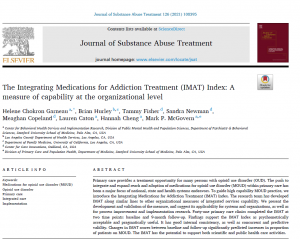As the death toll from opioid overdose soars, public health experts are urging clinics to get lifesaving medications into the hands of people with opioid use disorder. To help clinics do just that while keeping an eye on quality control and safety, researchers in our Addiction Treatment Starts Here program and partners developed a set of tools to measure quality improvement called Integrating Medications for Addiction Treatment, or the IMAT Index for short.
Combined with quarterly performance measures, the IMAT Index helps evaluate and improve the quality of addiction treatment programs in primary care settings, according to Brian Hurley, MD, an addiction psychiatrist at the University of Los Angeles, who co-developed the tool with researchers including Drs. Helene Chokron Garneau and Mark McGovern, from Stanford University School of Medicine and CCI. Last month he presented the IMAT Index on a panel addressing measurement-based care at the national conference of the American Society of Addiction Medicine, where Hurley felt a new sense of hope in the air.

Brian Hurley, MD, in his residency days at Massachusetts General Hospital (Credit: PracticeLink)
“The mood of the conference was exuberant,” he recalls. “We were really excited to be able to get together, even if not in person, to talk about addiction medicine and all of the great things like the IMAT that are coming out in the field.”
There was also a sense of urgency, since more than half a million people in the United States have died from opioid overdoses over the last two decades. Drug overdoses, in fact, have surpassed traffic accidents, homicides, and firearms to become the leading cause of death in Americans under 50. Children and families have been the collateral damage in this tragedy, with an estimated 50 percent increase in foster care due to parental drug use since the mid-2000s, according to the latest available studies.
Given these stark figures, the response to the IMAT tool at the ASAM conference was immediate – and encouraging.
“People were intensely curious about the tool,” Hurley recalls, explaining that he and his colleagues also discussed the journey that a series of community health centers had taken to incorporate medications for addiction treatment and counseling. “The audience really wanted to know what interventions were effective in getting the clinics to offer medications for addiction treatment to their patients,” he said. “There were a lot of excellent questions about the tool and a really robust discussion.”

Journal of Substance Abuse Treatment article on the IMAT Index
Hurley, with Drs. Garneau and McGovern and colleagues, also published a study on the IMAT Index this spring in the Journal of Substance Abuse Treatment, which measured the progress of 41 safety net clinics in CCI programs that integrated medications for addiction treatment over a nine-month period. Multidisciplinary teams in the clinic completed the IMAT at baseline and again at nine months to evaluate various aspects of seven domains of patient care: infrastructure, clinic culture and environment, patient identification and initiating care, care delivery and treatment response, care coordination, workforce, and staff training and development, each of which have different items for the group to rate.
The tool proved to be internally consistent, useful not only in assessing capability but in its predictive validity: For each one-point increase on the IMAT, for example, the study found an increase in patients using medications for opioid use disorders.
Equally important, clinicians can calculate scores using the formula built into the IMAT’s Excel workbook, which then automatically charts their progress over time. Discussing their perceptions of each item, the group decides on the best rating on a 1 to 5 scale (with 1 representing ‘minimally integrated’ and 5 ‘fully integrated’), and transposes the ratings into the IMAT’s Excel workbook, which then calculates scores for each dimension and plots a handy line graph profile.
“Anything that saves a busy primary care practice a little bit of time, you know – like calculating the scores – they use it,” Hurley says. “I don’t know a lot of tools that do that type of scoring, so I like to think that we’re on the cutting edge of tools that are feasible for busy community health practices.”
Why does the tool focus on primary care rather than specialty addiction practices?
“Primary care is an ideal place to treat substance use disorder, especially since it’s people’s point of continuity with the medical system,” Hurley says. Primary care physicians are more readily available than specialists and twice as likely to prescribe medications for opioid use disorder, such as buprenorphine and injectable extended-release naltrexone. Patients also find getting care in primary care less stigmatizing. “Stigma is a huge reason that people avoid getting addiction treatment,” Hurley says. “It’s a legacy of outdated concepts that consider substance use disorders to be willful misbehavior.” Seeing your own doctor, he says, helps normalizes addiction as a chronic disease which, like diabetes, can be successfully treated with medication, counseling, and support.
The IMAT Index was developed as a practical, easy-to-use tool for primary care clinics treating substance use disorders – one that is evidence-based and incorporates the latest guidelines on addiction treatment. What differentiates the tool from others in the field is its team-based approach to care evaluation, which helps reduce bias by seeking input from multiple sources. In this process, representatives from every team in a clinic join in the assessment, which usually takes one and a half hours a day scattered over several sessions.
“Looking at addiction treatment in primary care, the universal finding is that you have to involve everyone, not just the nurses and the doctors,” Hurley says. “We’re talking about the nurse, doctor, social workers, scheduler, billing staff in the back and security guards in the front. One of the most important reasons the whole clinic has to be aligned is that the first person the patient typically sees when they walk in the door is the security guard. And if the patient says, ‘Hey, can you point me toward where they’re doing the buprenorphine?’ and the security guard says, ‘I don’t know what you’re talking about’ – or even worse, ‘Oh, we don’t do that here’ – that’s a problem.”
People often view recovery from substance use disorder as enormous undertaking, Hurley adds. “I think we have in our heads that to do addiction treatment requires an individual to go through an extensive process of personal transformation. And I’m all for patients achieving full remission when they are ready. But the process of recovery can start off with a simple conversation with your doctor, along with basic counseling and support. And for opioid addiction in particular, the medications for addiction treatment seem to be really, really effective at keeping patients alive, engaged, and feeling better. They can have a dramatic and almost immediate effect to reduce the chances that someone’s going to die in an overdose. And the best place to do that is primary care.”
Tammy Fisher, vice-president of CCI and director of the program Addiction Treatment Starts Here, agrees. A co-author of the Journal of Substance Abuse Treatment article, she says, “The IMAT is a great place for primary care practices to start when developing Medications for Addiction Treatment programs within primary care to treat opioid use disorder (OUD). It provides a roadmap for change and enables practices to measure their changes over time. Transformation is a journey, and with this tool, practices can get started in small ways and celebrate quick wins no matter how incremental the change might be.”
References
Helene Chokron Garneau, Brian Hurley, Tammy Fisher, Sandra Newman, Meaghan Copeland, Lauren Caton, Hannah Cheng, Mark P. McGovern. (2021). The Integrating Medications for Addiction Treatment (IMAT) Index: A measure of capability at the organizational level. Journal of Substance Abuse Treatment.
Helene Chokron Garneau is affiliated with the Department of Psychiatry and Behavioral Sciences, Stanford University School of Medicine; Brian Hurley with the Los Angeles County of Health Services and the Department of Family Medicine at UCLA; Tammy Copeland, Sandra Newman, and Meaghan Copeland with the Center for Care Innovations; and Hannah Cheng, Lauren Caton, and Mark P. McGovern with the Division of Primary Care and Population Health, Department of Medicine, Stanford University School of Medicine.
Find this useful or interesting? We’re constantly sharing stuff like this. Sign up to receive our newsletter to stay in the loop.


